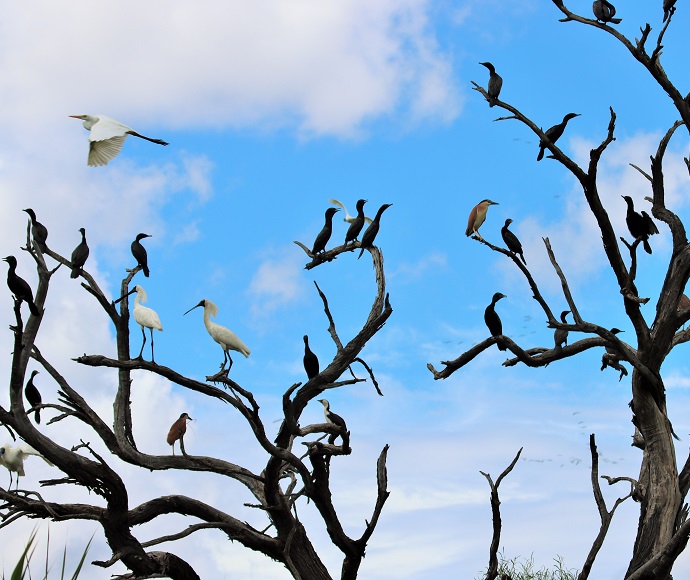The Intersecting Streams catchment comprises 4 key river systems: the Paroo and Warrego rivers, the Culgoa–Birrie–Bokhara–Narran connected system and Moonie River, which originates in Queensland and connects with the Barwon–Darling in wet years.
Most of the watercourses of the Intersecting Streams begin in Queensland and flow across the border into New South Wales, but some of the smaller watercourses on the south-eastern side of the Darling River are entirely in New South Wales.
The Paroo, Warrego, Culgoa, Condamine-Balonne, Narran and Moonie rivers begin their journey in the north of the Murray–Darling Basin. The Narran River terminates at Narran Lakes (except in very wet years). The other rivers connect with the Barwon–Darling River.
Together, these rivers are vital for transporting food and water across the landscape, providing critical habitat for native plants, fish and waterbirds.
Moonie River
The Moonie River originates in the Darling Downs and meets the Barwon–Darling near Mogil Mogil in northern New South Wales.
Warrego River
The Warrego River is an ephemeral waterway beginning in the Carnarvon Range. In its upper reaches, the Warrego is fed by several major tributaries. Further south, it branches, divides and returns. The Warrego provides important refuge for native fish and waterbirds.
Along its course, the Warrego River also supports a range of wetlands, including semi-permanent waterholes, lignum swamps, freshwater and saline lakes. One of the most significant is the Western Floodplain at Toorale National Park, which has upgraded infrastructure for managing flows between the river and the floodplain.
Narran River
The Narran River flows into the Narran Lakes system, north-east of Brewarrina. The river and lakes experience significant variability in flows, which has influenced the diversity of native plants and animals. It is an important breeding site for colonial nesting waterbirds and a refuge site during times of low or no flow.
Condamine River
The Condamine–Balonne rivers catchment is a significant source of water for the Barwon–Darling River. The Condamine River begins in the Darling Downs. Fed by several tributaries, it flows past Dalby, Chinchilla and onto Surat where it meets the Dogwood Creek and becomes the Balonne River. From there, the river flows south through St George before branching into a network of waterways, including the Culgoa, Bokhara and Narran rivers.
In wetter times, the Bokhara and Culgoa rivers meet the Barwon–Darling River downstream of Brewarrina. The catchment is home to several significant ecological communities that support a range of native plants, animals, and migratory birds.
Paroo River
The Paroo River is an ephemeral waterway, flowing when significant rains fall in the north of the catchment. It connects with the Darling River only under wet conditions. Most of the time, the Paroo River exists as a series of waterholes, lakes and wetlands.
The Intersecting Streams have significant cultural and spiritual importance for Aboriginal people. A tradition of spiritual and physical contact with the rivers, creeks and wetlands of the Murray–Darling Basin spans many thousands of years. The landscape continues to be a source of food, shelter, medicine and spiritual connection.
The Intersecting Streams is a sparsely populated region. Dryland agriculture, tourism and associated employment are the major drawcards for visitors and residents alike.
Why the Intersecting Streams need water for the environment
The Paroo River is an unregulated and considered the last truly unregulated river system in the Murray-Darling Basin. Dams and weirs control much of the water movement in the other major river systems of the Intersecting Streams.
Water management structures include:
- Beardmore Dam, Leslie Dam and Cooby Dam on the Condamine–Balonne system
- Cunnamulla Weir and Boera Dam on the Warrego River.
Management of water for the environment in the Intersecting Streams
Water is set aside in the Intersecting Streams catchment to support the river system's health. However, watering actions in the NSW portion of the Intersecting Streams area cannot be managed in the same way that water for the environment can be managed in other regulated systems because most of the inflow comes from Queensland.
The NSW Government works with the Commonwealth Environmental Water Holder to manage water in the catchment.


